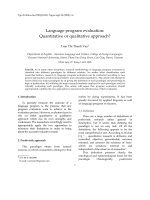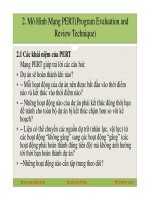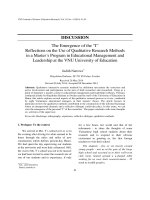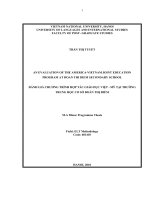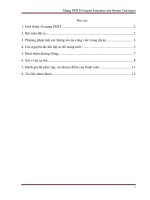qa-program-evaluation-research-checklist
Bạn đang xem bản rút gọn của tài liệu. Xem và tải ngay bản đầy đủ của tài liệu tại đây (119.02 KB, 7 trang )
COMIRB document
COMPARISON OF THE CHARACTERISTICS OF RESEARCH, QUALITY IMPROVEMENT, AND PROGRAM EVALUATION ACTIVITIES
RESEARCH
QUALITY IMPROVEMENT
PROGRAM EVALUATION
COMMENTS
INTENT
Intent of project is to develop
Intent of project is to improve a
Intent of project is to improve a
or contribute to generalizable
practice or process within a particular
specific program
knowledge (e.g., testing
institution or ensure it confirms with
hypotheses)
expected norms
DESIGN
Designed to develop or
Not designed to develop or contribute
Not designed to develop or contribute
contribute to generalizable
to generalizable knowledge; generally
to generalizable knowledge; does not
knowledge; may involve
does not involve randomization to
involve randomization of individuals, but
randomization of individuals to
different practices or processes
may involve comparison of variations in
different treatments, regimens, or
programs
processes
MANDATE or
Activities not mandated by
Activity endorsed or mandated by the
Activity endorsed or mandated by the
ENDORSEMENT
institution or program
institution or clinic as part of its
program, usually its funder, as part of its
operations
operations
EFFECT ON
Findings of the study are not
Findings of the study are expected to
Findings of the evaluation are expected
PROGRAM OR
expected to directly affect
directly affect institutional practice and
to directly affect the conduct of the
PRACTICE
institutional or programmatic
identify corrective action(s) needed
program and identify improvements
EVALUATED
practice
POPULATION
Usually involves a subset of
Information on all or most receiving a
Information on all or most participants
individuals - universal
particular treatment or undergoing a
within or affected by receiving a
participation of an entire clinic,
particular practice or process expected to
particular treatment or undergoing a
program, or department is not
be included; exclusion of information
particular practice or process expected to
expected; generally, statistical
from some individuals significantly
be used; exclusion of information from
justification for sample size used
affects conclusions. Initial work can be
some individuals significantly affects
to ensure endpoints can be met
limited to a smaller subgroup to identify
conclusions
and plan for implementation or feasibility
etc. with the expectation that the practice
or process will be extended to the broader
population.
BENEFITS
Participants may or may not
Participants expected to benefit
No benefit to participants expected;
benefit directly – benefit, if any,
directly from the activities
evaluation concentrates on program
to individuals incidental or
improvements or whether the program
delayed
should continue
DISSEMINATION OF
Intent to publish or present
Dissemination of information may
Intent to publish or present generally
RESULTS
generally presumed at the outset
occur in quality improvement
presumed at the outset of the project;
of project as part of professional
publications/fora; when published or
dissemination of information to program
expectations, obligations;
presented to a wider audience, the intent
stakeholders and participants; may be
dissemination of information
is to suggest potentially effective models, publicly posted (e.g., website) to ensure
usually occurs in
strategies, assessment tools or provide
transparency of results; when published
research/scientific publications or benchmarks or base rates rather than to
or presented to a wider audience, the
CF-350 Version 2/25/2015
QA/QI/Program Evaluation/Research Checklist
COMIRB document
other research/scientific fora;
results expected to develop or
contribute to generalizable
knowledge by filling a gap in
scientific knowledge or
supporting, refining, or refuting
results from other research studies
CLINICAL SETTINGS
USE OF PLACEBO
DEVIATION FROM
STANDARD
PRACTICE
Use of placebo may be planned
May involve significant
deviation from standard practice
develop or contribute to generalizable
knowledge. Any publication should
footnote that the project was carried out
as QA and did not meet the definition of
research per DHHS regs.
intent is to suggest potentially effective
models, strategies, assessment tools or
provide benchmarks or base rates rather
than to develop or contribute to
generalizable knowledge. Any publication
should footnote that the project was
carried out as QA and did not meet the
definition of research per DHHS regs.
Comparison of standard treatments,
practices, techniques, processes – placebo
would NOT be used
Unlikely to involve significant
deviation from standard practice
Definitions:
Human Subjects Research
For the purposes of this policy “human subject research” is defined as an activity that meets the definition of “research” and involves “human
subjects” as defined either by the Common Rule or by FDA regulations.
Research
A systematic investigation, including development, testing and evaluation, designed to develop or contribute to generalizable
knowledge. Activities that meet this definition may be funded or unfunded, or may be conducted as a component of another
program not usually considered research. For example, demonstration and service programs may include evaluation components,
and may constitute research activities under this definition.
For the purposes of this policy, a “systematic investigation” is an activity that involves a prospective study plan which incorporates
data collection, both quantitative and qualitative, and data analysis to answer a study question.
Investigations designed to develop or contribute to generalizable knowledge are those designed to draw general conclusions (i.e.,
knowledge gained from a study may be applied to populations outside of the specific study population), inform policy, or
generalize findings.
Research as defined by FDA regulations means any experiment that involves a test article and one or more human subjects, and
that either must meet the requirements for prior submission to the Food and Drug Administration under section 505(i) or 520(g) of
the Federal Food, Drug, and Cosmetic Act, or need not meet the requirements for prior submission to the Food and Drug
CF-350 Version 2/25/2015
QA/QI/Program Evaluation/Research Checklist
COMIRB document
Administration under these sections of the Federal Food, Drug, and Cosmetic Act, but the results of which are intended to be later
submitted to, or held for inspection by, the Food and Drug Administration as part of an application for a research or marketing
permit. The terms research, clinical research, clinical study, study, and clinical investigation are synonymous for purposes of FDA
regulations. [21 CFR 50.3(c), 21 CFR 56.102(c)]
Experiments that must meet the requirements for prior submission to the Food and Drug Administration under section 505(i) of
the Federal Food, Drug, and Cosmetic Act means any use of a drug other than the use of an approved drug in the course
of medical practice. [21 CFR 3 12.3(b)]
Experiments that must meet the requirements for prior submission to the Food and Drug Administration under section 520(g)
of the Federal Food, Drug, and Cosmetic Act means any activity that evaluates the safety or effectiveness of a device.
[21 CFR 812.2(a)]
Any activity in which results are being submitted to or held for inspection by FDA as part of an application for a research or
marketing permit is considered to be FDA-regulated research. [21 CFR 50.3(c), 21 CFR 56.102(c)].
Human Subject as defined by the Common Rule
A living individual about whom an investigator (whether professional or student) conducting research obtains:
1.
2.
data through intervention or interaction with the individual, or
identifiable private information.
Intervention includes both physical procedures by which data are gathered (for example, venipuncture) and manipulations of the
subject or the subject's environment that are performed for research purposes.
Interaction includes communication or interpersonal contact between investigator and subject.
Private information includes information about behavior that occurs in a context in which an individual can reasonably expect that
no observation or recording is taking place, and information which has been provided for specific purposes by an individual and
which the individual can reasonably expect will not be made public (for example, a medical record).
Private information must be individually identifiable (i.e., the identity of the subject is or may readily be ascertained by the
investigator or associated with the information) in order for obtaining the information to constitute research involving human
subjects.]
CF-350 Version 2/25/2015
QA/QI/Program Evaluation/Research Checklist
COMIRB document
Human Subject as Defined by FDA Regulations
Any individual who is or becomes a subject in research; either as a recipient of the test article or as a control. A subject may be
either a healthy human or a patient. In the case of a medical device, a human subject/participant is also means a human on whose
specimen an investigational device is used.
Research Compared with Quality Improvement/Quality Assurance or Program Evaluation
The touchstones for separating quality improvement and program evaluation from research concern the intent of the project, the
degree to which results are designed to contribute to generalized knowledge, the effect of results on program practice or processes, and
the scope of dissemination of results. In general many research methods may also be used in quality improvement and program
evaluation projects. In clinical settings the use of a placebo or significant deviation from standard of care is unlikely to be viewed as
quality improvement or program evaluation.
Quality Improvement:
Quality improvement activities are generally pursued in order to evaluate existing local practices with a goal of documenting and
correcting deficiencies. If the goal of a project is to determine success/effectiveness or failure of a given program or process and
the information gained from that evaluation is used to improve the program, this is not considered research involving human
subjects, even when information is collected in a systematic way, because the results of this type of activity are not considered
applicable to populations other than those under evaluation. Publication or presentation is allowed but results must not be
described as or inferred to be generalizable to a broader population, i.e., they may not be described as research results.
If, however, quality improvement activities involving human subjects are used to test novel services or programs for effectiveness
and are presented in a more global fashion or applied to a broader population they should be considered research involving human
subjects.
For example: efforts to assess current clinic practices within a hospital (i.e., local) and to modify those practices to improve
effectiveness would not meet the federal definition of research even though the evaluations collected data in a systematic manner.
Presentation within the local environment (i.e., to the hospital staff) and publication of the results would be acceptable, so long as
results are described as quality improvement and application of the findings is clearly limited to the location where they were
found. If, however, results are presented outside of the local environment at a national meeting or published in a journal using
language that seeks to generalize results beyond the locality of the project or that describes the study as research, the study would
CF-350 Version 2/25/2015
QA/QI/Program Evaluation/Research Checklist
COMIRB document
be considered human subject research and need review by the relevant IRB. Another example of research subject to IRB review
would be efforts to assess current clinical practices of a number of local, unrelated entities and the aggregation of all these efforts
to support a change in clinical practice beyond the local. As to each local organization, the assessment might constitute quality
improvement, but when the results are aggregated to support a more generalizable recommendation, OHRP has determined that the
aggregation of separate quality improvement activities constitutes research.
Program Evaluation:
Program evaluation is the inquiry into past, present, and potential programs to understand or clarify their needs, working
processes, or impact. When the purpose of the evaluation is to provide feedback to the program and/or funder to improve that
program, the activity is not human subject research and does not need IRB review and/or approval. Presentation of findings to the
program and its funders and publication of the results would be acceptable, so long as results are described as program evaluation
efforts and are clearly limited to the program to which they apply and are not described as research. Program evaluation is
considered human subjects research when the intent is to contribute to generalizable knowledge. If results are presented or
published using language that seeks to generalize results beyond the program studied, the study would be considered human
subject research and would need review by the relevant IRB.
Examples of evaluations that would be considered research and need human subjects review include: 1) dissemination of
evaluations connected to outcomes to affect the development or implementation of other programs similar in nature; and 2)
evaluation undertaken to test a new, modified, or previously untested intervention, service, or program to determine whether it is
effective and can be used elsewhere.
Even when activities constitute quality improvement or program evaluation, it is expected that the gathering of data from human subjects through
direct or indirect interaction will done with the highest level of regard for the protection of human subjects and in accord with ethical standards.
CF-350 Version 2/25/2015
QA/QI/Program Evaluation/Research Checklist
COMIRB document
***COMIRB USE ONLY – COMPLETE WHEN THIS DOCUMENT SERVES AS IRB REVIEWER’S CHECKLIST***
Reviewer
Submission ID
Principal Investigator
Protocol #
REVIEWER CHECKLIST— NOT HUMAN SUBJECT RESEARCH
YES
NO
COMMENTS or N/A
A. Is the project research as defined by DHHS:
Does the activity involve a systematic investigation?
AND
Does the activity intend to develop or contribute to generalizable
knowledge?
1
Is the project research as defined by FDA:
Is the activity an experiment that involves a test article or any activity
in which results are being submitted to or held for inspection by FDA
as part of an application for a research or marketing permit?
An activity is an experiment that involves a test article when it is:
1.1
Any use of a drug other than the use of an approved
drug in the course of medical practice
a. Any activity that evaluates the safety or effectiveness of a
device
CF-350 Version 2/25/2015
QA/QI/Program Evaluation/Research Checklist
COMIRB document
COMIRB Review Determination:
Qualifies as Not Human Subject Research
Are Minor Modifications Requested?
Yes
No
Reviewer Signature:_________________________________________________
ADDITIONAL COMMENTS:
Date:_____________
See typed/electronic comments
CF-350 Version 2/25/2015
QA/QI/Program Evaluation/Research Checklist
